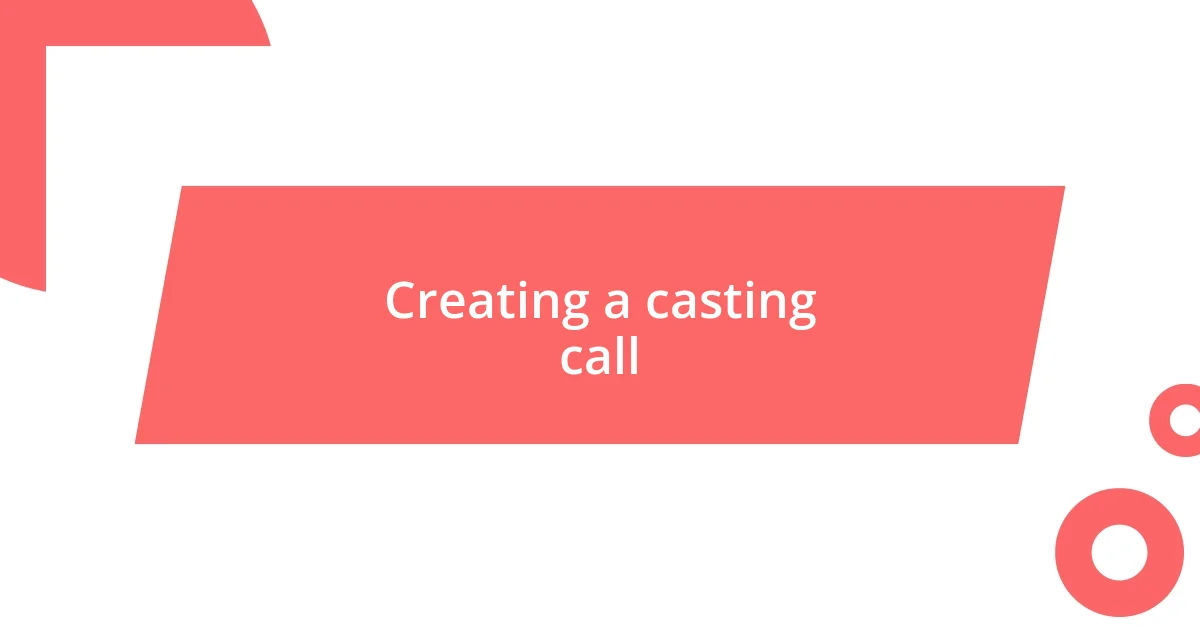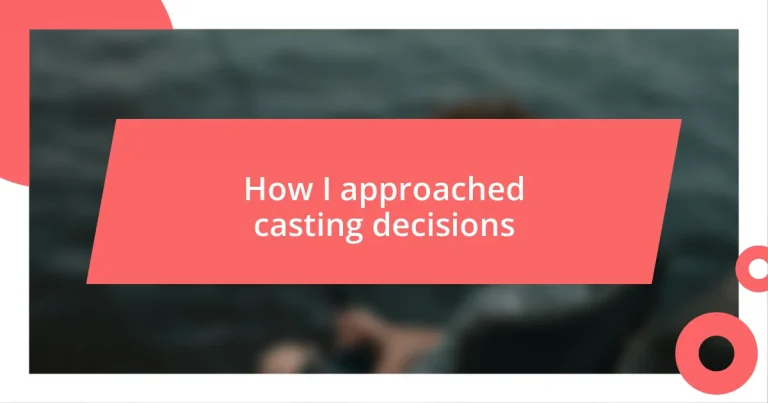Key takeaways:
- Effective casting relies on both individual talent and the chemistry between actors to create compelling dynamics and elevate storytelling.
- Defining a clear project vision is essential, guiding the casting process and ensuring alignment with the narrative’s emotional tone and character complexities.
- Collaboration with the creative team and considering actors’ chemistry plays a crucial role in making final casting decisions, often influencing the overall success of the production.

Understanding the casting process
Casting can often feel like an intricate puzzle where each piece must fit perfectly to create a cohesive whole. Reflecting on my own experiences, I remember the nerve-wracking moments in the room as talented actors brought their unique energy to the table. I often found myself wondering—what truly makes one audition stand out from another?
In evaluating potential candidates, I’ve learned that chemistry between actors can be just as crucial as their individual talent. During a casting call for a drama, I observed two actors who barely knew each other click instantly, igniting a palpable energy that was impossible to ignore. Isn’t it fascinating how sometimes the unexpected pairings create the most compelling dynamic?
The casting process is not solely about finding the best actors; it’s about envisioning the story as a whole. I recall a project where I had a clear vision, yet the right actor wasn’t the one I initially imagined. It was a reminder that sometimes, the choices we make in casting can lead to wonderfully surprising outcomes that enrich the narrative in ways we never anticipated.

Defining the project vision
Defining the project vision is an essential first step in my casting journey. I often start by visualizing the project’s core themes and emotional tone. For instance, while working on a romantic comedy, I sketched out the characters’ arcs and the humor intertwined with deeper emotions. This process allowed me to identify the qualities I needed in the actors—ones who could effortlessly switch between laughter and heartfelt moments. Have you ever thought about how a clear vision can guide your decisions? It definitely shapes mine.
When I reflect on past projects, I remember the pivotal role that a well-defined vision played in the casting of a historical drama. We needed actors who not only resembled the characters but also understood the nuances of that era. I recall a casting session where one actor, while auditioning, brought such authenticity that it felt as if we were transported back in time. It reaffirmed my belief that aligning casting choices with the project’s vision can elevate the entire storytelling experience.
As I honed my approach to casting, I realized that the project vision serves as a north star, guiding every decision. In one instance, during a fantasy film, I envisioned a complex character who needed to embody strength and vulnerability. When I met an actress who delivered a performance that encapsulated both traits, the sheer connection cemented my decision. Every time I define the project vision, I remind myself that it not only influences who gets cast but also shapes the essence of the narrative itself.
| Project Type | Importance of Vision |
|---|---|
| Romantic Comedy | Shapes Humor and Emotion |
| Historical Drama | Ensures Authenticity of Performance |
| Fantasy Film | Guides Character Complexity |

Identifying character profiles
Identifying character profiles is a crucial step in the casting process, one that often reveals the heart of the narrative. I find it essential to distill the essence of each character into clear attributes and motivations. For instance, during a project where I was casting for a gritty thriller, I spent hours crafting profiles that detailed not just the characters’ backgrounds but also their emotional journeys. This exercise helped me visualize who could authentically inhabit those roles.
Here’s how I break down character profiles:
- Archetype: Define if they’re the hero, villain, mentor, etc.
- Backstory: What past experiences shape their worldview?
- Emotional Range: What emotions do they predominantly express, and how do they handle conflict?
- Goals and Motivations: What drives them? What do they want?
- Relationships: How do they interact with other characters?
With this framework, I remember casting for a romantic drama where I needed a character who was both strong and vulnerable. After fully immersing myself in her profile, I realized that finding an actress who could balance those attributes was paramount. When I finally met a performer who delivered a heartfelt audition that encapsulated both strength and vulnerability, I truly felt the character spring to life before me. It was one of those magical moments when everything just clicked.

Creating a casting call
Creating a casting call is a nuanced art form that goes beyond just listing roles. I find it essential to communicate not only the characters needed but also the emotional depth and specific traits I’m looking for in performers. For instance, I once tailored a casting call for a film about overcoming personal trauma, where I emphasized the need for actors to have a strong connection to vulnerability. Isn’t it fascinating how the right words can attract an entirely different caliber of talent?
When drafting the call, I often include clear descriptions and a vibe that resonates with the project’s core themes. For a recent project, I described one character as someone who “laughs easily but hides their pain behind a smile.” This not only helped actors better understand who they were auditioning for but also invited them to reflect on their own experiences, creating a more genuine audition environment. Have you considered how a well-phrased casting call can actually influence the audition’s emotional depth?
I also pay close attention to the logistics of the casting call. Listing the audition process, timeline, and any specific requirements is crucial. There was a time when I overlooked this, leading to confusion for both the casting team and actors. It reinforced my belief that clarity can make the difference between a chaotic casting session and a smooth one. Each detail really counts – after all, the goal is to draw out the best performances and ensure actors feel supported in sharing their talents.

Evaluating audition performances
Evaluating audition performances is where the magic truly happens. When sitting in the audition room, I focus not just on the lines being delivered but on the emotional truth behind them. I remember a time when an actress walked into the room and approached a character I had been envisioning for weeks. Her performance wasn’t technically perfect, but the raw emotion she conveyed swept me off my feet. How often do we see talent that speaks directly to our hearts?
During auditions, I also look for authenticity. It’s about those subtle nuances—the flicker of doubt in their eyes or the way they breathe into a moment of silence. I recall conducting auditions for a play centered on familial relationships. A young actor played a moment of tension between siblings with such honesty that I felt as if I was intruding on a real-life conflict. Isn’t that the kind of performance that makes great storytelling possible?
I gravitate towards performers who can take risks and embrace vulnerability. For instance, I evaluate how well they can switch between emotions or fully immerse themselves in their character’s psyche. Once, I saw a performer who took a seemingly mundane scene and infused it with layers of complexity simply through body language and facial expressions. It made me wonder—how often do we underestimate the power of non-verbal communication in an audition? In my experience, those moments are often the most telling, revealing not just an actor’s talent but their potential for growth within a role.

Collaborating with creative team
Collaboration with the creative team is essential for making informed casting decisions. I remember a particularly intense brainstorming session with directors and producers for a unique project, and it was fascinating to see how different perspectives shaped our vision. As we shared ideas, I could almost feel the energy shift in the room—those sparks of creativity can lead to casting choices that resonate with the story’s heart. Have you ever experienced that rush when collaborating with others who share your passion?
Engaging with the creative team allows for deeper discussions about character motivations and how each actor’s unique qualities can bring those characters to life. In one instance, I suggested a performer with a quirky energy for a role that initially seemed straightforward. To my surprise, the team fully embraced this fresh direction. It’s incredible how stepping out of our comfort zones can lead to richer narratives and unexpected connections among the cast.
I also prioritize regular check-ins with the team throughout the casting process. There was a time when we missed aligning on a character’s essence, leading to mixed signals during auditions. By fostering open dialogue, we learned to express any doubts or insights right away, transforming our approach into a more cohesive one. Isn’t it amazing how a simple conversation can clear the air and ultimately enhance the casting process?

Making final casting decisions
When making those final casting decisions, I often find myself revisiting key moments from auditions. There was a time when I had to choose between two exceptionally talented actors for the same role. One brought a grounded approach, while the other delivered a performance bursting with energy. It struck me—what story do I want to tell? I ultimately leaned towards the actor whose passion ignited something in the script that I hadn’t even anticipated. That decision reminded me how crucial intuition can be in casting.
It’s not just about who can deliver lines well; it’s about who embodies the character. Once, I faced a dilemma where an actress’s previous work didn’t reflect the depth she presented in her audition. After consulting with my creative team, we realized that this actress might just need the right environment to shine. This experience reinforced my belief that the potential for authenticity often outweighs past credentials. Have you ever taken a leap of faith on someone’s raw potential?
I also consider the chemistry between actors during this stage. I recall a particularly memorable callback session where two performers transformed the room with their electric connection. It was as if they had been playing those characters for years. The energy shifted, leaving no doubt in my mind—they were meant to share this journey together. How often do we underestimate the magic that arises when actors genuinely connect? In my experience, that chemistry can elevate the entire production, creating a richer, more immersive experience for the audience.














